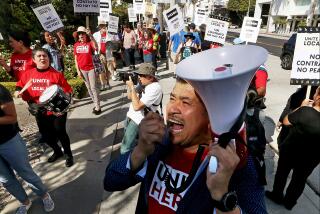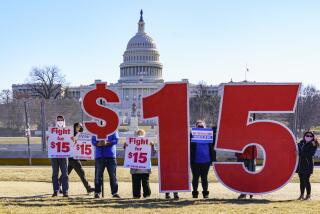Editorial: What’s the right minimum wage? We still don’t have the answer

On Saturday, minimum wage workers at larger businesses in the cities of Los Angeles, Santa Monica and Pasadena, as well as in unincorporated communities in Los Angeles County, will get a big bump up in hourly pay — from $10.50 to $12.
This is the next step toward the $15 minimum wage that these communities will start requiring in 2020. California’s statewide minimum wage, which is on a slightly slower track, is scheduled to reach $15 by 2022. (Both the city and state laws delay the increases by one year for businesses with 25 or fewer employees.)
While the pay hikes are settled law in Los Angeles and California, the impact of such a significant increase is still very much a matter of debate among researchers. Case in point: This month two new studies analyzing the effects of Seattle’s minimum wage increase reached two very different conclusions.
Raising the minimum wage is an attempt to alleviate just one symptom of the larger problems of poverty and income inequality.
Researchers at the University of Washington found that after base pay was bumped up to $13 last year, wages for the lowest-paid workers increased — but their work hours decreased. The net result, researchers said, was a decrease in low-wage employees’ average earnings of $125 a month. The number of low-wage jobs also declined compared with cities outside of Seattle that did not raise the minimum wage. Notably, the study did not include low-wage workers at franchises with multiple outlets. Nevertheless, its finding is worrisome: If low-paid workers end up worse off on average at $13 an hour, what will happen at $15 an hour?
In a separate analysis, researchers at UC Berkeley studied the impact of the wage on Seattle’s food services industry, which is often used as stand-in for the low-wage sector overall because so many workers in restaurants get paid at or near the minimum wage. The Berkeley team found that pay went up and the number of jobs didn’t change. Supporters of the increases said the study affirmed that cities can raise the minimum wage without sacrificing jobs.
Predictably, economists and labor advocates immediately began picking apart the two Seattle studies, both of which have limitations based on the availability of data and the assumptions that their authors made in designing the research.
And so the debate over minimum-wage hikes continues, to the frustration of policymakers looking for clear guidance on how to help their low-income constituents. While there is general consensus that modest increases in the minimum wage don’t upend the job market, there is little agreement on what exactly is a “modest increase.” And there’s still no conclusive research on how local governments can find the sweet spot, or the highest point to which base pay can be raised before employers start reducing hours and workers and undercut the benefit of the minimum wage increase.
Seattle’s experience with the minimum wage will provide more grist for that mill. And the data could be unusually helpful because the state of Washington collects data not only on how much their residents earn, but also how many hours they work.
Researchers at UCLA are studying the minimum wage increases in Los Angeles and statewide, but they have less detailed data to work with, especially at the local level. If it really wants to gauge the value of wage floors, the state needs to start collecting and crunching more detailed wage and hour data.
It’s also worth remembering that raising the minimum wage is an attempt to alleviate just one symptom of the larger problems of poverty and income inequality. Lawmakers still need to stay focused on the structural issues that are fueling poverty in California. That means laying the groundwork for more $30-an-hour-plus jobs that put people on a path to the middle class. It also means making sure the education system is giving students the skills and training to take those more advanced jobs. And it means ensuring workers can afford to live here by building more housing.
Follow the Opinion section on Twitter @latimesopinion and Facebook
More to Read
A cure for the common opinion
Get thought-provoking perspectives with our weekly newsletter.
You may occasionally receive promotional content from the Los Angeles Times.










